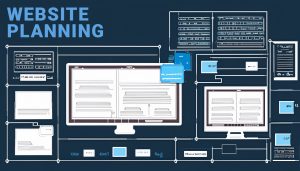Your website’s design is the first impression visitors get of your brand, setting the stage for how they interact with your content. But an alluring design goes beyond aesthetics—it’s about creating an inviting and functional interface that resonates with users. Achieving this requires a well-planned layout, a harmonious color palette, and intuitive interfaces that guide users effortlessly.
Imagine walking into a stylish store: the space, colors, and lighting work together to create a welcoming atmosphere. Your website design should do the same. When designing, think about what makes your brand unique and how to visually communicate that through layout, typography, and visuals.
Compelling Content: Building Connections
If design is the store’s layout, content is what brings visitors in and keeps them interested. Content is the heartbeat of your website; it’s what informs, engages, and persuades. Well-crafted content includes not just text but also relevant images, videos, and multimedia elements that bring your brand’s message to life.
Successful content doesn’t just inform—it speaks directly to the needs and interests of your audience. Focus on creating content that’s clear, actionable, and valuable, whether that means educating, inspiring, or addressing a common pain point for your visitors.
Seamless Navigation: Guiding the Journey
Navigation is about more than just finding information; it’s about creating a journey that makes exploring your website a pleasure. Intuitive navigation ensures that users can find what they’re looking for quickly and without confusion, which is key to keeping them engaged. This involves logically organizing content, using clear and concise menu labels, and structuring your pages so that users know exactly where to go next.
Think of navigation as a road map, where each road or path is clearly marked and leads to valuable destinations. By making navigation intuitive, you’re making it easier for users to connect with your offerings and helping them move smoothly toward a call to action.
Security and Privacy: Building Trust
In an era where data breaches and online threats are common, security can’t be overlooked. Safeguarding user information with robust security measures establishes trust and credibility. It’s essential to implement encryption, secure authentication methods, and regular updates to keep your site secure and assure users that their data is safe.
Think of security as a guard at the entrance of a high-end store: users feel reassured when they know their privacy is being respected. Establishing a secure website isn’t just a precaution; it’s a trust-builder that adds value to your brand’s reputation.
Mobile and Tablet Optimization: Reaching Users on Every Device
As mobile usage continues to grow, optimizing your website for mobile and tablet users is non-negotiable. A site that performs flawlessly across devices offers a consistent, professional experience, whether a visitor is browsing on their phone, tablet, or desktop.
Responsive design, or the ability for your site to adapt to various screen sizes, ensures that images, text, and functionality remain intact on any device. This adaptability is crucial for user satisfaction, as visitors expect a seamless experience regardless of the device they’re using.
SEO: Attracting Organic Traffic
For your website to attract a steady stream of visitors, visibility on search engines is essential. Search Engine Optimization (SEO) involves optimizing content, meta tags, images, and other elements to improve search rankings. SEO brings organic traffic to your site, making it easier for potential customers to find you without paid ads.
SEO can be likened to placing your store on a busy street where passersby are likely to see it. By optimizing for search engines, you’re enhancing your online visibility and expanding your reach to new audiences.
Responsive Design: Ensuring Consistent User Experience
Responsive design is the ability for your website to adjust seamlessly across different devices and screen sizes. This means a visitor using a smartphone should have an equally smooth experience as someone on a desktop computer. Employing responsive design techniques, like flexible grids, CSS media queries, and optimized images, ensures that your website is functional and visually pleasing on any screen.
Responsive design is about offering consistency—whether on a smartphone, tablet, or desktop. It communicates to visitors that you value their experience, no matter how they access your site.
How NonStop Marketing Can Enhance Your Web Presence
At NonStop Marketing, we specialize in building websites that excel in each of these critical elements. We understand the unique challenges that businesses face online and are here to help you create a website that’s not only visually compelling but also functionally robust. A well-crafted website can transform how your brand is perceived and can turn casual visitors into loyal customers.
Our approach ensures that each element—from design to content and security—contributes to an experience that engages users and drives results. If you’re ready to create a website that speaks to your audience and stands out in the digital landscape, let’s discuss how we can work together to elevate your online presence.




